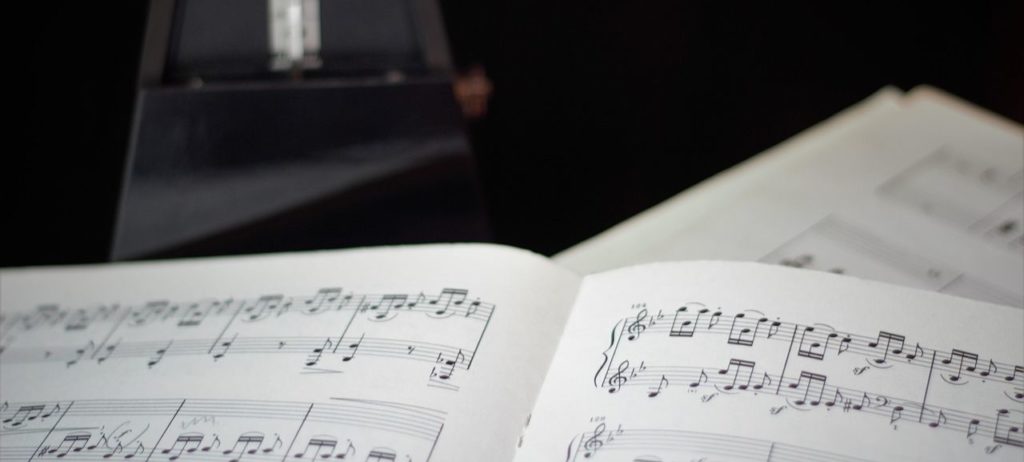The Math in Music, Part I: The Math in Rhythm
GET STARTED
Introduction
Welcome to the first of a three-part exploration of the mathematics underpinning much of the music we enjoy today. What follows is just an overview of some fundamental elements; however, the world of math in music runs much deeper. In fact, in a sense, music is math.
Like chemistry, computer programming, filmography, fluid dynamics, archery, bread baking, particle physics, and more, music can be well- represented with mathematical concepts. I find it helpful to organize these concepts into three rough categories:
- Rhythm (that’s today topic)
- Pitch
- Form
Now, for the curious, we could go further and say that sound itself—pressure waves of variable amplitude and frequency, traveling through a medium such as air—is also mathematical; and for that matter, so is air pressure, and the vibrations that cause sound waves in the first place, and our ability to process sound information in our ears and neurons… we’re getting a little outside our purview for today, but for those interested, Max Tegmark’s Our Mathematical Universe should scratch the itch.
Of course, if you have any questions on the info below, ask your music teacher, or learn how to find a talented one!
The Basics of Rhythm
So what is rhythm? Defining a musical concept is a wonderful way to start a musicological argument, so for now, kindly accept my definition: organizing sound according to placement in time. That’s it. “Rhythm” describes the temporal organization of sound.

So if I ding my glass of water with a pencil, and then immediately afterward my dog barks simultaneously with a car horn from outside, was that rhythm?
Yes, it was!
Albeit perhaps not such great music. (For the curious, John Cage has a lot to say about the boundaries of what constitutes music—a great subject for another day.)
For a more conventional example of rhythm, try clapping six quarter notes in succession, at a medium tempo, followed by a half note. Then repeat five times.
Seriously, do it! I’ll wait.
Ok, great job. If just clapping through this pattern sounded vaguely like Twinkle, Twinkle, Little Star to your ears, you’re not alone. Our brains are extremely adept at combing through even the simplest sounds for patterns, and they are equally adept at building connections between those patterns and the things you know—thus, your brain took what was a series of low-information sounds, organized in time, and found meaning in them.

Notes and Rests
Musician readers probably see the wealth of useful information contained in the Twinkle score above: key signature, time signature (meter), pitch, lyrics, form. But even underneath that, there is the musical information you just uncovered in the form of notes and rests, which describe integer ratios of sound onsets and durations.
Or, to state it more clearly: notes and rests tell you when to begin a sound (“sound onset”) and how long until the subsequent sound (“duration”), with the various lengths and timings having values defined in relation to each other (“integer ratios”)—i.e., a quarter note is equal to two eighth notes, which is a note length ratio of 2:1.
Sounds like math, right? Yes! But these ratios also have musical information within them, even without the aid of any other elements.
We already found music in (1/1/1/1/1/1/2) (aka Twinkle). How about (1/1/1/1/1/1/2/1/1/1/1/4), taken at a slightly faster pace than Twinkle? You got it—Old MacDonald. And on and on: (3/1/3/1/1/1/1/1/4) (Eine Kleine Nachtmusik), (1/2/1/2/1/2/1/2/1/2/1/2/1/5) (Amazing Grace), (1/1/1/2/3/1/1/1/2/1/1/2/1/1/2/1/1/9/1/1/1/5) (Eleanor Rigby)…
Our musician readers have probably sniffed out the trick by now. For any one of these examples, try subbing in a dotted-quarter note for 3, a quarter note for 2, an eighth note for 1, and a half note for 4, and you will discover a pretty good transcription of a famous melody. That’s because, at their core, notes and rests are just mathematical ratios.
Meter
So, besides notes and rests, and for that matter, pitch and lyrics, what other elements are present in the Twinkle score? More importantly, are they mathematical?

I think you know what answer to expect by now. Yes, of course! Meter is a tool used in Western music to organize phrases. Contrary to what you might assume, meter doesn’t determine the rhythm of notes, and it is wholly unnecessary to make rhythms recognizable (you just discovered that for yourself above).
A properly stuffy musicologist might go even further at this point and tell you that meter is actually a completely separate concept from rhythm—but that’s not useful for our current purposes. What you need to know is that meter tells you roughly how many notes you can expect in a phrase, and where to place musical emphasis among those notes. How does it do that?
Why, yes, more ratios. Note the C on the left side of each staff of the Twinkle score. This refers to “common time,” which is also expressed as 4/4, a meter signature (more frequently referred to as a “time signature”). It identifies the meter, and it roughly means that measures—which are like organizational guideposts created by the meter, placed along and between phrases—should be formed out of four beats of quarter notes (4 beats of 4-notes— 4/4—get it?).
So applied to the (1/1/1/1/1/1/2) of Twinkle, you get the above score, or (1/1/1/1/1/1/2 | 1/1/1/1/1/1/2); applied to Old MacDonald, you get (1/1/1/1/1/1/2 | 1/1/1/1/4 ); and Eine Kleine Nachtmusik becomes (3/1/3/1 | 1/1/1/1/4).
Do you see that if you add all the numbers in between each pipe symbol (“|”), you get eight? That is a deliberately engineered organizational tool and a mathematical consequence of meter.
Also, it’s useful: for example, if you’re improvising by playing eighth notes, and you know there are two measures until the end of the section, you can quickly determine that the maximum number of notes you can still play before the new section is 16 eighth notes.
And that’s just the tip of the iceberg—what if you wanted to accent every third eighth note going by? Well, if you have four measures left to play until the end of the section, you can play your three-note idea ten times maximum. Etc.
Meters get more complex as well—intrepid readers may have noticed that the Amazing Grace rhythm won’t fit nicely into measures created within common time. But try 6/8. (/1 | 2/1 /2/1 | 2/1/2/1 | 2/1/2/1 | 5/); it works beautifully, right? And the same sum-per-measure concept emerges, but with six notes as the standard rather than eight.
Extra Credit
We’ve only just begun to explore the world of math in rhythm, and the paths one could take for further exploration branch off in many different directions. For example, notes and phrases can be extended over measure divisions (and, in some rare cases, even meter divisions); what does this mean for the math governing their ratios?
Furthermore, meter itself can be found in some pretty unusual ratios (think 11/8), or related to other meters via unusual ratios (4/4 where an eighth note equals a quintuplet of the preceding meter), or even exist as what we might describe in the West as a polymeter (such as what’s sometimes found in the traditional music of the Ewe people of West Africa); can we make sense of all of this rhythmic diversity through math?
The answer, as you know by now, is yes: music is math!
In Conclusion
Understanding the relationship between math and music as it relates to rhythm, pitch, and form enables students to learn and enjoy music even more. Not to mention the benefits increasing your knowledge of math along the way.
As always, a music teacher is an invaluable resource for getting personally acquainted with the elements of music, mathematical or otherwise—perhaps now is the right time to find a good fit and start taking lessons at an Ensemble Music School near you.
Author: Jake St. John
Jake is a professional drummer, semi-professional cellist, and experienced, self-taught administrator whose time at the helm of several small commercial media businesses led to coming onboard with Ensemble Music Schools in 2021.
As Head of Operations, Jake is involved in all functions of the company, but especially those related to finance and human resources, as well as directly overseeing our growing East Coast portfolio.




